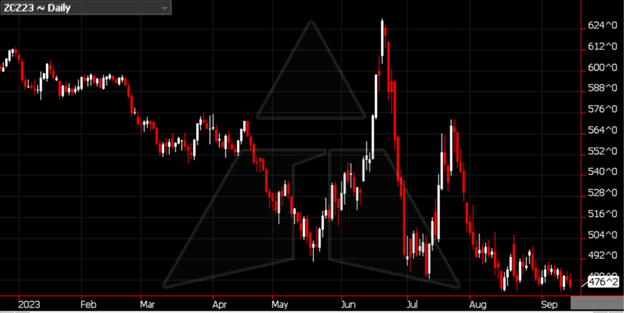
Fall is the time of year when corn and soybean farmers get to see if our hard work and expenses have paid off. You put in many long hours throughout the year, run several different "tests" in fields, and endure a handful of sleepless nights and bad weather, hoping to make some money when harvest time comes around.
Right now we're trying to make money on a corn crop that has dropped more than $1.30 in price since January.
Selling this year’s corn crop hasn’t been easy. From the beginning, expenses were elevated for the 2023 crop, making breakeven prices higher than in previous years. December new crop futures were at $6.11 on Jan. 3, and they only traded above that mark on three occasions later in the year (June 21-23).

Is storage the answer?
Many will consider putting their crop into storage this year, hoping for an increase in price that outweighs costs. They may be thinking, "Why not if you can participate in a post-harvest rally -- and the price can't keep going lower, right?"
However, this type of thinking has gotten others into trouble before and will continue to do so in the future. Maybe storage has worked out in the past, but it's best to consider another option before pulling the trigger.
Let's compare putting your corn into commercial storage versus making a cash sale off the scale and buying a call option. Consider:
Call options give you the right but not the obligation to buy corn at a certain price.
Calls gain value as the corn market rallies and lose value as the market falls.
The significant benefit of calls is that they limit risk due to only being able to lose a set amount. For example, if you spend 25 cents on a call after making a cash sale of corn, you can only lose that 25 cents even if the corn market falls by $1.00.
Let's look at the numbers to compare commercial storage against a cash sale paired with a call option.
Storage rates for corn vary by elevator, but typical rates in the corn belt may include an 18 cent "drop fee" and then 4 cents a month after that. Some elevators will also charge for drying and shrink your corn down to 14% instead of 15% when putting it into storage; that costs an additional 5 cents even as you lose an extra 2.8 bushels on 200-bushel corn. That shrink is $12/acre or another 6 cents per bushel. All together, if you want to put corn into storage until December, you are going to be paying 41 cents (the 18 cent drop fee, 5 cents for drying, 6 cents for shrink, and 12 cents for 3 months of storage).
The kicker is that if the corn market drops in price, you lose on that too.
Comparatively, the fees for a call option are quite simple. At the time of this writing, an at-the-money December $4.75 call is 16 cents. Add a broker's fee of 3 cents to get a total cost of 19 cents to have upside potential until November 24th.
With December futures currently at $4.75, here are some price scenarios to put the numbers to the test:
Corn rallies to $6.00
Storage net price = $5.59 ($6.00 sale – 41 cents)
Corn stays at $4.75
Storage net price = $4.34 ($4.75 sale – 41 cents)
Corn falls to $4.00
Storage net price = $3.59 ($4.00 sale – 41 cents)
Clearly, in all these scenarios, a sale with a call is the better route to take.
What about basis?
Storage can take advantage of one aspect that a sale with a call can't: improvement in basis. But in any of these situations, you need basis to improve at least 22 cents to break even. The risk does not seem worth the reward in my mind.
You can buy calls to extend your timeframe, or you can start with a December call and roll it out to a longer term later. Calls give you great flexibility to participate in a rally but limit your risk substantially.
So, this fall, when you have delivered on all your contracts, filled your bins, and have to do something with your "extra" bushels, consider using call options. The numbers speak for themselves. Enjoy this fall season and have a safe harvest!
Contact Advance Trading at (800) 747-9021 or go to www.advance-trading.com.
Information provided may include opinions of the author and is subject to the following disclosures:
The risk of trading futures and options can be substantial. All information, publications, and material used and distributed by Advance Trading Inc. shall be construed as a solicitation. ATI does not maintain an independent research department as defined in CFTC Regulation 1.71. Information obtained from third-party sources is believed to be reliable, but its accuracy is not guaranteed by Advance Trading Inc. Past performance is not necessarily indicative of future results.
The opinions of the author are not necessarily those of Farm Futures or Farm Progress.
Read more about:
Grain StorageAbout the Author(s)
You May Also Like






